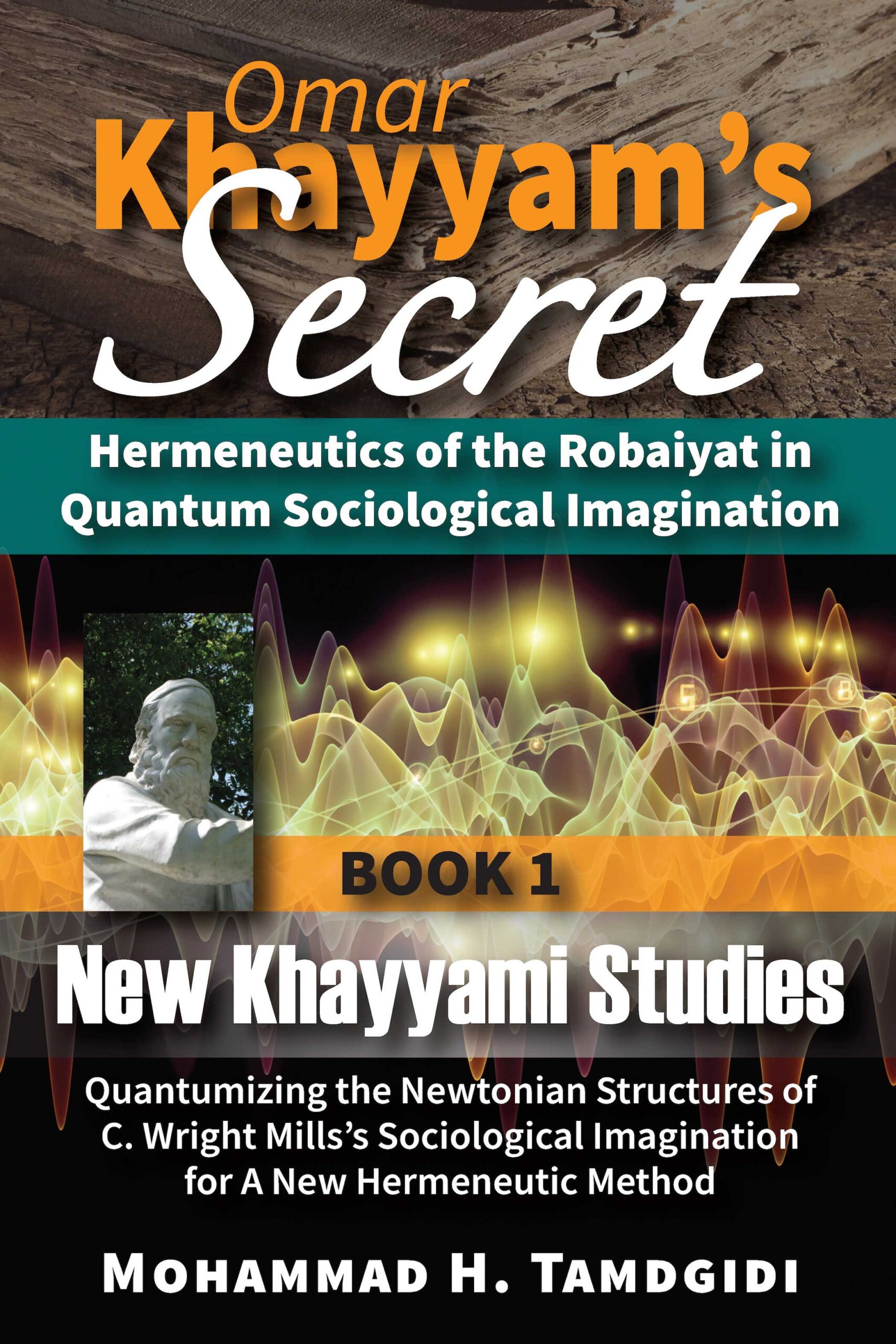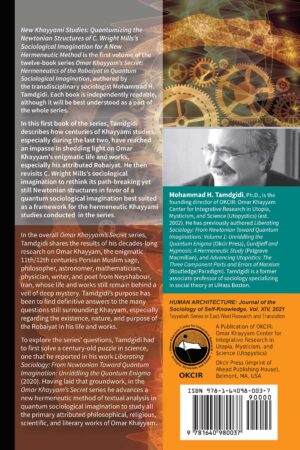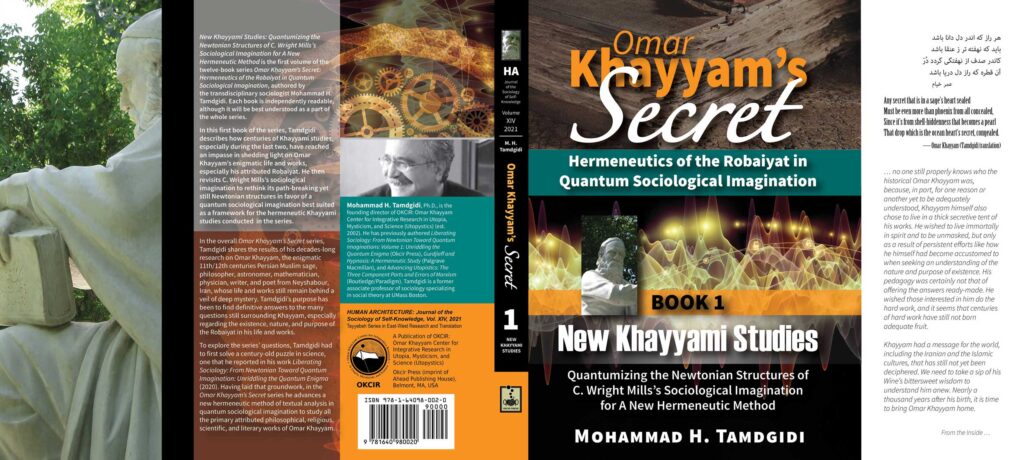Omar Khayyam’s Secret: Hermeneutics of the Robaiyat in Quantum Sociological Imagination: Book 1: New Khayyami Studies: Quantumizing the Newtonian Structures of C. Wright Mills’s Sociological Imagination for A New Hermeneutic Method
$69.99 – $99.00
In this book of his Omar Khayyam’s Secret series, Mohammad H. Tamdgidi revisits C. Wright Mills’s sociological imagination to rethink its Newtonian structures toward quantum hermeneutic frameworks for Khayyam and Robaiyat studies.
Publication Date: June 1, 2021
Note: The ePub ebook edition of this title (ISBN: 9781640980044) can be purchased from major online ebook stores worldwide.

All the sections of this publication can be read online by logged-in members of the OKCIR Library with a valid access. In that case click on any section in the table of contents below, and then click on the large PDF icon at the bottom of that page to access the publication section. Alternatively, you can purchase this publication as offered below.
Description
Omar Khayyam’s Secret: Hermeneutics of the Robaiyat in Quantum Sociological Imagination
Book 1: New Khayyami Studies
Quantumizing the Newtonian Structures of C. Wright Mills’s Sociological Imagination for A New Hermeneutic Method
Author: Mohammad H. Tamdgidi
Publication Date: June 1, 2021
Human Architecture: Journal of the Sociology of Self-Knowledge (ISSN: 1540-5699)
Volume XIV, 2021, Monograph Series: Tayyebeh Series in East-West Research and Translation
Description
Omar Khayyam’s Secret: Hermeneutics of the Robaiyat in Quantum Sociological Imagination is a twelve-book series of which this book, subtitled New Khayyami Studies: Quantumizing the Newtonian Structures of C. Wright Mills’s Sociological Imagination for A New Hermeneutic Method, is the first volume. Each book is independently readable, although it will be best understood as a part of the whole series.
In the overall series, the transdisciplinary sociologist Mohammad H. Tamdgidi shares the results of his decades-long research on Omar Khayyam, the enigmatic 11th/12th centuries Persian Muslim sage, philosopher, astronomer, mathematician, physician, writer, and poet from Neyshabour, Iran, whose life and works still remain behind a veil of deep mystery. Tamdgidi’s purpose has been to find definitive answers to the many puzzles still surrounding Khayyam, especially regarding the existence, nature, and purpose of the Robaiyat in his life and works. To explore the questions posed, he advances a new hermeneutic method of textual analysis, informed by what he calls the quantum sociological imagination, to gather and study all the attributed philosophical, religious, scientific, and literary writings of Khayyam.
In this first book of the series, following a common preface and introduction to the series, Tamdgidi develops the quantum sociological imagination method framing his hermeneutic study in the series as a whole. In the prefatory note he shares the origins of this series and how the study is itself a moment in the trajectory of a broader research project. In his introduction, he describes how centuries of Khayyami studies, especially during the last two, have reached an impasse in shedding light on his enigmatic life and works, especially his attributed Robaiyat.
The four chapters of the book are then dedicated to developing the quantum sociological imagination as a new hermeneutic method framing the Khayyami studies in the series. The method builds, in an applied way, on the results of Tamdgidi’s recent work in the sociology of scientific knowledge, Liberating Sociology: From Newtonian Toward Quantum Imagination: Volume 1: Unriddling the Quantum Enigma (2020), where he explored extensively, in greater depth, and in the context of understanding the so-called “quantum enigma,” the Newtonian and quantum ways of imagining reality. In this first book, he shares the findings of that research in summary amid new applied insights developed in relation to Khayyami studies.
In the first chapter, Tamdgidi raises a set of eight questions about the structure of C. Wright Mills’s sociological imagination as a potential framework for Khayyami studies. In the second chapter, he shows how the questions are symptomatic of Newtonian structures that still continue to frame Mills’s sociological imagination. In the third chapter, the author explores how the sociological imagination can be reinvented to be more in tune with the findings of quantum science. In the last chapter, the implications of the quantum sociological imagination for devising a hermeneutic method for new Khayyam and Robaiyat studies are outlined. In conclusion, the findings of this first book of the Omar Khayyam’s Secret series are summarized.
About the Author
Mohammad H. Tamdgidi, Ph.D., is the founding director and editor of OKCIR: Omar Khayyam Center for Integrative Research in Utopia, Mysticism, and Science (Utopystics) and its journal, Human Architecture: Journal of the Sociology of Self-Knowledge (ISSN: 1540-5699), which have served since 2002 to frame his independent research, pedagogical, and publishing initiatives. He is a former associate professor of sociology specializing in social theory at UMass Boston and has taught sociology at SUNY-Binghamton and SUNY-Oneonta.
Besides his currently in progress work published in the book series Omar Khayyam’s Secret: Hermeneutics of the Robaiyat in Quantum Sociological Imagination (Okcir Press), Tamdgidi has previously authored Liberating Sociology: From Newtonian Toward Quantum Imaginations: Volume 1: Unriddling the Quantum Enigma (2020, Okcir Press), Gurdjieff and Hypnosis: A Hermeneutic Study (2009, Palgrave Macmillan), and Advancing Utopistics: The Three Component Parts and Errors of Marxism (2007, Routledge/Paradigm). He has published numerous peer reviewed articles and chapters and edited more than thirty journal issues.
Tamdgidi holds a Ph.D. and M.A. in sociology in conjunction with a graduate certificate in Middle Eastern studies from Binghamton University (SUNY). He received his B.A. in architecture from U.C. Berkeley, following enrollment as an undergraduate student of civil engineering in the Technical College of the University of Tehran, Iran.
His areas of scholarly and practical interest are the sociology of self-knowledge, human architecture, and utopystics-three fields of inquiry he invented in his doctoral studies and has since pursued as respectively intertwined theoretical, methodological and applied fields of inquiry altogether contributing to what he calls the quantum sociological imagination. His research, teaching, and publications have been framed by an interest in understanding how world-historical social structures and personal selves constitute one another. This line of inquiry has itself been a result of his longstanding interest in understanding the underlying causes of failures of the world’s utopian, mystical, and scientific movements in bringing about a just global society.
It was during his undergraduate studies at U.C. Berkeley and in the course of his mentorship by the painter and design architect Jesse Reichek (1916-2005) that Tamdgidi’s notion and project “human architecture” was born. During his graduate studies at SUNY-Binghamton, he was mentored in methods, theory, and world-systems studies by Terence K. Hopkins (1928-1997) and Immanuel Wallerstein (1930-2019), and further in dialectics by Dale Tomich and on space and society by Anthony D. King, amid a uniquely autonomous and flexible transdisciplinary Graduate Program in Sociology founded by T. K. Hopkins.
Omar Khayyam’s Secret: Hermeneutics of the Robaiyat in Quantum Sociological Imagination: Book 1: New Khayyami Studies: Quantumizing the Newtonian Structures of C. Wright Mills’s Sociological Imagination for A New Hermeneutic Method
Published by: Okcir Press (an imprint of Ahead Publishing House) • Belmont, Massachusetts • First Edition: June 1, 2021
284 pages • 6×9 inches • Includes references, illustrations, bibliography, and index
Library of Congress Control Number (LCCN): 2021906754
ISBN: 9781640980020 (hard cover with dust jacket: alk. paper)
ISBN: 9781640980037 (soft cover: alk. paper)
ISBN: 9781640980044 (ePub ebook)
ISBN: 9781640980051 (PDF ebook)
CITATION: Tamdgidi, Mohammad H. 2021. Omar Khayyam’s Secret: Hermeneutics of the Robaiyat in Quantum Sociological Imagination: Book 1: New Khayyami Studies: Quantumizing the Newtonian Structures of C. Wright Mills’s Sociological Imagination for A New Hermeneutic Method. (Human Architecture: Journal of the Sociology of Self-Knowledge: Vol. XIV, 2021. Tayyebeh Series in East-West Research and Translation.) Belmont, MA: Okcir Press.
Where to Purchase this Book: The various editions of this volume can be ordered from the Okcir Store and all major online bookstores worldwide (such as Amazon, Barnes&Noble, Google Play, and others).
Table of Contents
Omar Khayyam’s Secret: Hermeneutics of the Robaiyat in Quantum Sociological Imagination: Book 1: New Khayyami Studies: Quantumizing the Newtonian Structures of C. Wright Mills’s Sociological Imagination for A New Hermeneutic Method
Acknowledgments—xvii
1. The Problem of Dualism: Can Personal Troubles Be Also Public Issues, and Vice Versa?—33
2. The Problem of Atomism: Which Self’s Personal Trouble Is It?—36
3. The Problem of Separability: Whose Public Issues Are These?—38
4. The Problem of Objectivity: Can We as Observers Separate Ourselves from Others’ Personal Troubles and Public Issues?—43
5. The Problem of Determinism: Is It Always the Case that Only Society Shapes the Individual/Self, and That Only Public Issues Shape Personal Troubles, and Not Also the Other Way Around?—48
6. The Problem of Continuity: Are We Supposed to Find Causal Relations Amid Easily Locatable and Traceable Causal Chains?—53
7. The Problem of Disciplinarity: Are We Always Better Off Dividing and Specializing Our Knowledges Into Fragmented Disciplines?—55
8. The Problem of Scientism: Is Science Always Western, and Still Newtonian?—57
1. Dualism: Can An Object Be A And Non-A at the Same Time?—68
2. Atomism: What Is the Micro Unit of Analysis of the Object?—72
3. Separability: What Is the Macro Unit of Analysis of the Object?—82
4. Objectivity: Does the Object, While Being Observed, Have An Independent Reality?—86
5. Determinism: Are Causes and Consequences In Objects Certain and Predictable?—92
6. Continuity: Is Influence Exerted Through Chains of Local-Causations?—96
7. Disciplinarity: Fragmenting Our Knowledge of Reality?—98
8. Scientism: Presuming the Superiority of Western, Newtonian Way of Thinking?—99
1. Relating Personal Troubles and Public Issues: From Dualism to Simultaneity (Not “Duality,” Nor “Complementarity”)—126
2. Relating Personal Troubles (or Not) of Many Selves: From Atomism to Superpositionality—131
3. Relating Public Issues World-Historically: From Separability to Inseparability—139
4. Relating the Sociological Imaginations of Others to Those of Ourselves: From Subjectless Objectivity to Relativity (Subject-Included Objectivity)—142
5. Reimagining Causal Patterns Creatively: From Determinism to Probability—148
6. Reimagining Causal Chains Also As Causal Leaps: From Continuity to “Transcontinuity” (Also Known As “Discontinuity”)—154
7. Reimagining Sociology: From Disciplinarity Toward Transdisciplinarity—158
8. Reimagining Science: From Eurocentrism to Transculturalism—161
1. The Availability of Sources on Omar Khayyam—178
2. Prioritization and Superpositions of Available Sources on Khayyam—190
3. Khayyami Studies and the Hermeneutic Method—195
4. On Secrets and Being Secretive—204
Book 1 Index—251
List of Figures
Figure 2.1: Visual Expression of the Newtonian Sociological Imagination—107
Figure 3.1: Visual Representations of the Quantum Way of Thinking about the Sociological Imagination—173
Figure 4.1: Khayyami Studies’ Sources Mapped Onto the Substantive Whole-Part Dialectical Schema —193








